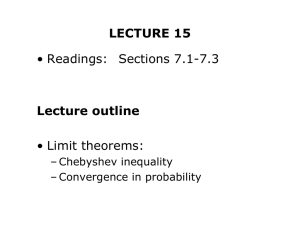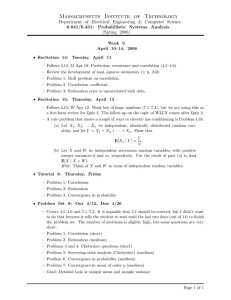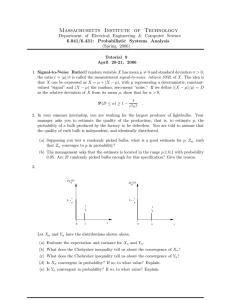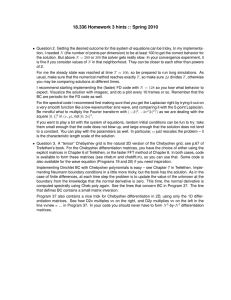Variants of Chebyshev`s Method with Optimal Order of Convergence
advertisement
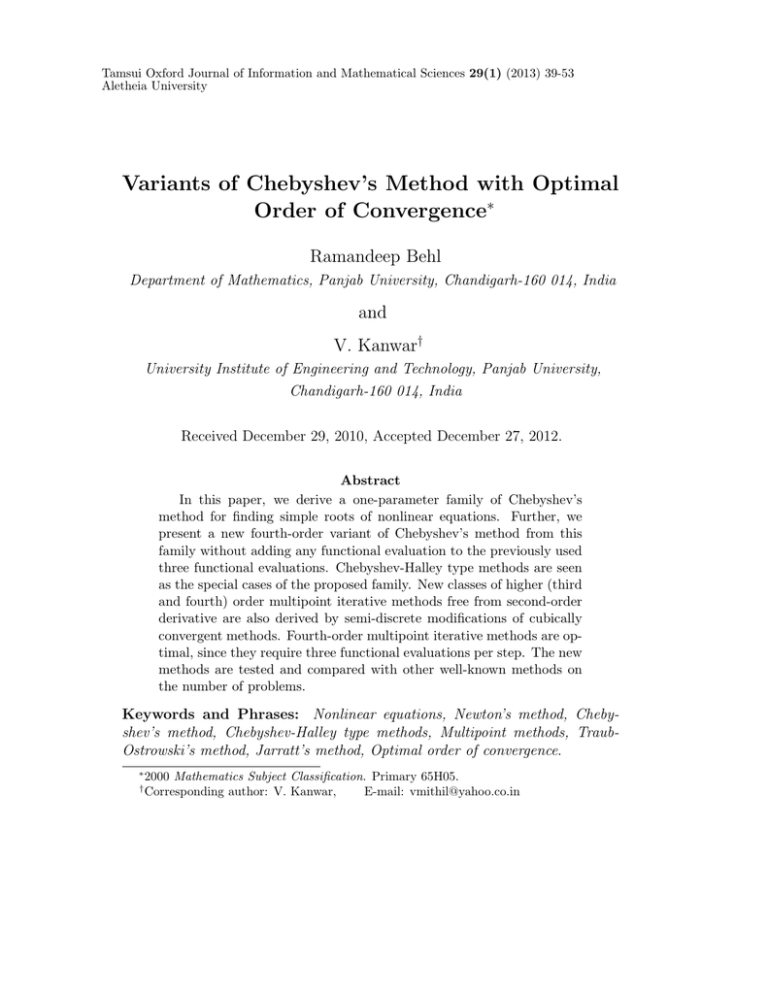
Tamsui Oxford Journal of Information and Mathematical Sciences 29(1) (2013) 39-53
Aletheia University
Variants of Chebyshev’s Method with Optimal
Order of Convergence∗
Ramandeep Behl
Department of Mathematics, Panjab University, Chandigarh-160 014, India
and
V. Kanwar†
University Institute of Engineering and Technology, Panjab University,
Chandigarh-160 014, India
Received December 29, 2010, Accepted December 27, 2012.
Abstract
In this paper, we derive a one-parameter family of Chebyshev’s
method for finding simple roots of nonlinear equations. Further, we
present a new fourth-order variant of Chebyshev’s method from this
family without adding any functional evaluation to the previously used
three functional evaluations. Chebyshev-Halley type methods are seen
as the special cases of the proposed family. New classes of higher (third
and fourth) order multipoint iterative methods free from second-order
derivative are also derived by semi-discrete modifications of cubically
convergent methods. Fourth-order multipoint iterative methods are optimal, since they require three functional evaluations per step. The new
methods are tested and compared with other well-known methods on
the number of problems.
Keywords and Phrases: Nonlinear equations, Newton’s method, Chebyshev’s method, Chebyshev-Halley type methods, Multipoint methods, TraubOstrowski’s method, Jarratt’s method, Optimal order of convergence.
∗
†
2000 Mathematics Subject Classification. Primary 65H05.
Corresponding author: V. Kanwar,
E-mail: vmithil@yahoo.co.in
40
Ramandeep Behl and V. Kanwar
1. Introduction
One of the most important and challenging problem in computational mathematics is to compute approximate solutions of the nonlinear equation
f (x) = 0.
(1)
Newton’s method for multiple roots appears in the work of Schröder [1], which
is given as
f (xn )f 00 (xn )
.
(2)
xn+1 = xn − 0
{f (xn )}2 − f (xn )f 00 (xn )
This method has quadratic convergence, including the case of simple root.
Another well-known third-order modification of Newton’s method is the classical Chebyshev’s method [2, 3], given by
xn+1 = xn −
f (xn )
1 {f (xn )}2 f 00 (xn )
−
.
f 0 (xn ) 2 {f 0 (xn )}3
(3)
In this paper, we obtain a new general family of Chebyshev’s method
for finding simple roots of nonlinear equations numerically. The classical
Chebyshev-Halley methods [4] are obtained as the particular cases of our proposed scheme. Further, we have also developed a new fourth order variant of
Chebyshev’s method. The beauty of this method is that it uses the same number of functional evaluations as that of classical Chebyshev’s method. Therefore, the efficiency of our proposed fourth-order method in terms of functional
evaluations is better than the existing classical Chebyshev’s method. Furthermore, we also develop two new optimal fourth-order multipoint methods free
from second-order derivative.
2. Family of Chebyshev’s Method and Convergence Analysis
Let r be the required root of equation (1) and x = x0 be the initial guess
known for the required root. Assume
x1 = x0 + h, |h| << 1,
(4)
Variants of Chebyshev’s Method with Optimal Order of Convergence
41
be the first approximation to the root. Therefore
f (x1 ) = 0.
(5)
Expanding the function f (x1 ) by Taylor’s theorem about x0 and retaining the
terms up to O(h2 ), we get
f (x0 ) + hf 0 (x0 ) +
h2 00
f (x0 ) = 0.
2
(6)
Further simplifying, we get
f (x0 )
h2 f 00 (x0 )
h=− 0
−
.
f (x0 )
2 f 0 (x0 )
(7)
Approximating h on the right-hand side of equation (7) by the correction term
f (xn )f 00 (xn )
− {f 0 (x)}
2 −af (x )f 00 (x ) , a ∈ R (free disposable parameter) given in formula (2),
n
n
we obtain
1
{f (x0 )}2 f 0 (x0 )f 00 (x0 )
f (x0 )
− h=− 0
(8)
.
f (x0 ) 2 {f 0 (x0 )}2 − af (x0 )f 00 (x0 ) 2
Thus the first approximation to the required root is given by
x 1 = x0 −
1
f (x0 )
{f (x0 )}2 f 0 (x0 )f 00 (x0 )
−
.
f 0 (x0 ) 2 {f 0 (x0 )}2 − af (x0 )f 00 (x0 ) 2
(9)
Therefore, the general formula for successive approximations can be written
as
xn+1 = xn −
f (xn )
1
{f (xn )}2 f 0 (xn )f 00 (xn )
−
,
f 0 (xn ) 2 {f 0 (xn )}2 − af (xn )f 00 (xn ) 2
or
f (xn )
1
{f (xn )}2 f 0 (xn )f 00 (xn )
−
.
f 0 (xn ) 2 {f 0 (xn )}4 + a2 {f (xn )}2 {f 00 (xn )}2 − 2af (xn ){f 0 (xn )}2 f 00 (xn )
(10)
This formula looks like a Chebyshev’s formula and describes the oneparameter family of Chebyshev’s method. Note that for a = 0 in (10), one
can immediately recover the classical Chebyshev’s formula.
Special cases
I. Chebyshev-Halley type methods
xn+1 = xn −
42
Ramandeep Behl and V. Kanwar
If we remove the term a2 {f (xn )}2 {f 00 (xn )}2 from the denominator: {f 0 (x)}4 +
a2 {f (xn )}2 {f 00 (xn )}2 − 2af (xn ){f 0 (xn )}2 f 00 (xn ) in formula (10), we obtain a
family of methods defined by
xn+1 = xn −
1
{f (xn )}2 f 00 (xn )
f (xn )
−
.
f 0 (xn ) 2 {f 0 (x)}3 − 2af (xn )f 0 (xn )f 00 (xn )
This family resembles with the well-known cubically convergent family of
Chebyshev-Halley type methods [4].
II. Another new cubically convergent family of methods
If we remove the term − 2af (xn ){f 0 (xn )}2 f 00 (xn ) from the denominator:
{f 0 (x)}4 + a2 {f (xn )}2 {f 00 (xn )}2 − 2af (xn ){f 0 (xn )}2 f 00 (xn ) in formula (10), we
obtain a family of methods defined by
xn+1 = xn −
1
{f (xn )}2 f 0 (xn )f 00 (xn )
f (xn )
−
.
f 0 (xn ) 2 {f 0 (x)}4 + a2 {f (xn )}2 {f 00 (xn )}2
It is investigated that this family is also cubically convergent for all a ∈ R.
Theorem 2.1 Assume that f : D ⊂ R → R for an open interval D has a
simple root r ∈ D. Let f (x) be sufficently smooth in the neighborhood of the
root r, then the order of convergence of the methods defined by family (10) is
three for every value of a ∈ R.
Proof. Let en be the error at the nth iteration, then en = xn − r . Expanding
f (xn ) and f 0 (xn ) about r and using the fact that f (r) = 0, f 0 (r) 6= 0, we have
f (xn ) = f 0 (r)[en + c2 e2n + c3 e3n + c4 e4n + c5 + O(e5n )],
where ck =
1 f k (r)
,
k! f 0 (r)
(11)
k = 2, 3, . . . Furthermore, we have
f 0 (xn ) = f 0 (r)[1 + 2c2 en + 3c3 e2n + 4c4 e3n + 5c5 e4n + O(e5n )],
(12)
f 00 (xn ) = f 0 (r)[2c2 + 6c3 en + 12c4 e2n + 20c5 e3n + O(e4n )].
(13)
and
Then
3
4
f (xn )
2
2
3
=
[e
−
c
e
+
2
c
−
c
e
+
−4c
+
7c
c
−
3c
en + O(e5n )], (14)
n
2
3
2
3
4
n
2
n
2
f 0 (xn )
Variants of Chebyshev’s Method with Optimal Order of Convergence
and
f (xn )
f 0 (xn )
2
f 00 (xn )
2
2 3
=
[2c
e
+
6c
−
8c
en + O(e4n )].
2
3
n
2
0
f (xn )
43
(15)
Using (14) and (15) in equation (10) and simplifying, we get
en+1 = 2c22 (1 − 2a) − c3 e3n + O(e4n ).
(16)
Therefore, it can be concluded that for all a ∈ R, the family (10) converges
cubically. For a = 21 , error equation (16) reduces to
en+1 = −c3 e3n + O(e4n ).
(17)
3. Fourth-order Variant of a Chebyshev’s Method
and Convergence Analysis
Here we intend to develop a new optimal fourth-order variant of Chebyshev’s
method. This method is very interesting because it has very higher order of
convergence and computational efficiency unlike Chebyshev’s method.
Considering the Newton-like iterative method with a parameter α ∈ R
yn = xn − α
f (xn )
.
f 0 (xn )
(18)
We now modify family (10) of Chebyshev’s method by using the second-order
derivative at yn instead of xn and obtain
xn+1 = xn −
1 {f (xn )}2 f 0 (xn )f 00 (yn )
f (xn )
−
.
f 0 (xn ) 2 {f 0 (x)}2 − af (xn )f 00 (yn ) 2
(19)
Obviously, when we take (a, α) = (0, 0), we get classical Chebyshev’s method.
Theorem 3.1 Assume that f : D ⊂ R → R for an open interval D has a
simple root r ∈ D. Let f (x) be sufficently smooth in the neighborhood of the
root r, then the order of convergence
of the method defined by formula (19) is
1 1
of order four if (a, α) = 2 , 3 .
44
Ramandeep Behl and V. Kanwar
Proof. The proof of said convergence of method (19) canbe proved onsimilar
n)
about
lines as in the Theorem (2.1). Expanding f 00 (yn ) = f xn − α ff0(x
(xn )
x = r, we have
f 00 (yn ) =f 0 (r)[2c2 + 6c3 (1 − α)en + (6αc2 c3 + 12c4 (1 − α)2 e2n ) + (12αc3 (c3 − c22 )
+ 24c2 c4 α(1 − α) + 20c5 (1 − α)3 )e3n + O(e4n )].
(20)
Using (11), (12) and (20) in formula (19) and simplifying, we get the final
error equation as
en+1 ={(1 − 2a)2c22 − (1 − 3α)c3 }e3n + {(28a − 12a2 − 9)c32
+ (12 − 24a − 15α + 24aα)c2 c3 − (3 − 12α + 6α2 )c4 }e4n + O(e5n ).
(21)
For the method to be of fourth-order convergence, we must have
1 − 2a = 0 and 1 − 3α = 0,
which implies
1
1
and α = .
(22)
2
3
Using (22) in equation (21), we obtain the following error equation for fourthorder variant as
1
3
en+1 = 2c2 − c2 c3 + c4 e4n + O(e5n ).
(23)
3
√
The efficiency index [2] of the present method is equal√to 3 4 ∼
= 1.587 , which is
3
∼
better than
√ the ones of classical Chebyshev’s method 3 = 1.442 and Newton’s
method 2 2 ∼
= 1.414 respectively. Therefore, this method is very interesting
because it has higher order of convergence and computational efficiency than
Chebyshev’s method.
a=
4.
Families of Multipoint Iteration Methods
and their Convergence Analysis
The practical difficulty associated with the above mentioned methods given
by (10) or (19) may be the evaluation of second-order derivative. Recently,
Variants of Chebyshev’s Method with Optimal Order of Convergence
45
some new variants of Newton’s method free from second-order derivative have
been developed in [2, 3, 5, 6, 7, 8, 9] and the references cited theirin by discretization of second-order derivative or by predictor-corrector approach or
by considering different quadrature formulae for the computation of integral
arising from Newton’s theorem. These multipoint methods are of great practical importance since they overcome the limitations of one-point methods
regarding the convergence order and computational efficiency. According to
Kung-Traub conjecture [9], the order of convergence of any multipoint method
without memory consuming function evaluations per iteration, can not exceed
the bound (called optimal order). Thus, the optimal order for a method with
three functional evaluations per step would be four. Traub-Ostrowski’s method
[2, 3], Jarratt’s method [5], King’s method [6] and Maheswari’s method [7] etc.
are famous optimal fourth order methods, because they require three functions
evaluations per step. Nowadays, obtaining new optimal methods of order four
is still important, because they have very high efficiency index.
Here, we also intend to develop new fourth-order multipoint methods free
from second-order derivative. The main idea of proposed methods lies in the
discretization of second-order derivative involved in family (10) of Chebyshev’s
method.
a. First family
Expanding the function f (xn − βu), β 6= 0 ∈ R but finite, about the point
x = xn with f (xn ) 6= 0, we have
f (xn − βu) = f (xn ) − βuf 0 (xn ) +
Let us take u =
f (xn )
,
f 0 (xn )
β 2 u2 00
f (xn ) + O(e3n ).
2!
(24)
and inserting this into (24), we obtain
f (xn )f 00 (xn ) ≈
2{f 0 (xn )}2
{f (xn − βu) − (1 − β)f (xn )}.
β 2 f (xn )
(25)
Using the approximate value of f (xn )f 00 (xn ) into formula (10), we have
f (xn )
{f (xn − βu) − (1 − β)f (xn )}
2
xn+1 = xn − 0
1 + β f (xn )
.
f (xn )
{(β 2 + 2a(1 − β))f (xn ) − 2af (xn − βu)}2
(26)
Special cases
For different specific values of parameters a and α, the following various
46
Ramandeep Behl and V. Kanwar
multipoint methods can be deduced from (26), e.g.
i. For (a, β) = − 21 , 1 , we get the new formula
f (xn )
f (xn )f (xn − u)
xn+1 = xn − 0
1+
.
f (xn )
{f (xn ) + f (xn − u)}2
ii. For (a, β) = (−1, 1), we get the new formula
f (xn )f (xn − u)
f (xn )
1+
.
xn+1 = xn − 0
f (xn )
{f (xn ) + 2f (xn − u)}2
iii. For (a, β) = 12 , 1 , we get the new formula
f (xn )
f (xn )f (xn − u)
xn+1 = xn − 0
1+
.
f (xn )
{f (xn ) − f (xn − u)}2
(27)
(28)
(29)
Note that the family (26) can produce many more new multipoint methods by
choosing different values of the parameters.
b. Second family
Replacing the second-order derivative in (10) by the following definition
f 00 (xn ) ≈
f 0 (xn ) − f 0 (xn − βu)
, β 6= 0 ∈ R,
βu
we get the following new family as
f (xn )
1 βf 0 (xn ){f 0 (xn ) − f 0 (xn − βu)}
xn+1 = xn − 0
1+
.
f (xn )
2 {(β − a)f 0 (xn ) + af 0 (xn − βu)}2
(30)
Special cases
For different specific values of parameters a and β, the following various
multipoint methods can be obtained from (30), e.g.
i. For (a, β) = (1, 1), we get the new formula
f (xn )
f 0 (xn ){f 0 (xn ) − f 0 (xn − u)}
xn+1 = xn − 0
1+
.
(31)
f (xn )
2{f 0 (xn − u)}2
ii. For (a, β) = 12 , 23 , we get the new formula
"
#
12f 0 (xn ) f 0 (xn ) − f 0 xn − 32 u
f (xn )
xn+1 = xn − 0
1+
.
(32)
2
f (xn )
f 0 (xn ) + 3f 0 xn − 2 u
3
Variants of Chebyshev’s Method with Optimal Order of Convergence
47
Other modifications can be obtained from formula (10) by replacing the secondorder derivative by other finite difference approximations.
The order of convergence of family (26) and (30) will be studied in Theorem
4.1 in the subsequent section.
Theorem 4.1 Let f : D ⊆ R → R be a continuous and sufficiently differentiable function defined in D. If f (x) has a simple root r ∈ D, then for
sufficiently close initial guess x0 to r,
(i) the family (26) has 3rd order of convergence, for
1
1
1
a 6= & β = 1, a = & β 6= 1, a 6= & β 6= 1,
2
2
2
1
and 4th order of convergence for a = & β = 1.
2
(ii) the family (30) has 3rd order of convergence, for
1
2
1
2
1
2
a 6= & β = , a = & β 6= , a 6= & β 6= ,
2
3
2
3
2
3
1
2
th
and 4 order of convergence for a = & β = .
2
3
Proof. Since f (x) is sufficiently differentiable, expanding f (xn ) and f 0 (xn )
about x = r by Taylor’s expansion, we have
f (xn ) = f 0 (r)[en + c2 e2n + c3 e3n + c4 e4n + c5 e5n + O(e5n )],
(33)
f 0 (xn ) = f 0 (r)[1 + 2c2 en + 3c3 e2n + 4c4 e3n + 5c5 e4n + O(e5n )],
(34)
and
where ck and en are defined earlier.
f (xn −βu) = (1−β)en +{(1−β+β 2 )c2 }e2n −{2β 2 c22 −((1−β)3 +2β)c3 }e3n +O(e4n ).
(35)
Using symbolic computation in the programming package Mathematica, we
get the following error equation for the family (26):
en+1 ={2(1 − 2a)c22 − (1 − β)c3 }e3n + {(28a − 12a2 − 9)c32
+ (12 − 24a − 5β + 8aβ)c2 c3 − (3 − 4β + β 2 )c4 }e4n + O(e5n ).
For a =
1
2
(36)
and β = 1, in equation (36), we get
en+1 = (2c32 − c2 c3 )e4n + O(e5n ).
(37)
48
Ramandeep Behl and V. Kanwar
Similarly for scheme (30), we have the following error equation
en+1
3β
2
= 2(1 − 2a)c2 − 1 −
c3 e3n + (28a − 12a2 − 9)c32
2
(38)
15β
4
5
2
+ 12 − 24a −
+ 12aβ c2 c3 − (3 − 6β + 2β )c4 en + O(en ).
2
For a =
1
2
and β = 32 , in equation (36), we get
1
3
en+1 = 2c2 − c2 c3 + c4 e4n + O(e5n ).
9
(39)
5. Numerical Results
In this section, we shall present the numerical results obtained by employing
the methods namely Newton’s method (NM), Chebyshev’s method (CM), cubically convergent variant of Chebyshev’s method (10) for a = 1 (CVCM) and
quartically convergent variant of Chebyshev’s method (19) (QVCM) respectively to solve the nonlinear equations given in Table 1. The results are summarized in Table 2. We also compare Newton’s method (NM), Traub-Ostrowski’s
method (TOM), Jarratt’s method (JM), Maheswari’s method (MM) with our
optimal multipoint methods (29) (MTOM) and (32) (MJM) introduced in this
contribution. The results are summarized in Table 3. Computations have been
performed using C ++ in double precision arithmetic. We use = 10−15 . The
following stopping criteria are used for computer programs:
(i) |xn+1 − xn | < , (ii) |f (xn+1 )| < .
Variants of Chebyshev’s Method with Optimal Order of Convergence
49
Table 1: Test Problems
No Problems
[a, b]
Initial guess Root (r)
1. ex − 4x2 = 0
[0.5, 2]
0.5
0.714805901050568
2.0
3
2
2. x + 4x − 10 = 0
[1, 2]
1.0
1.3652300134140969
2.0
3. cos x − x = 0
[0, 2]
0.0
0.7390851332151600
2.0
2
x
4. x − e − 3x + 2 = 0
[0, 1]
0.0
0.000000000000000
1.0
x2
5. xe − sin x2 + 3 cos x + 5 = 0 [−1.5, − 0.5] −1.5
1.207647800445557
−0.5
6. sin2 x − x2 + 1 = 0
[1, 3]
1.0
1.404491662979126
3.0
x2 +7x−30
7. e
−1=0
[2.9, 3.5]
2.9
3.5
3.000000000000000
50
Ramandeep Behl and V. Kanwar
Table 2: Results of problems (Number of Iterations)
Problem
Initial guess
NM
CM
CVCM
QVCM
1.
0.5
4
3
3
2
2.0
5
4
4
3
1.0
4
3
3
2
2.0
4
3
3
2
0.0
4
3
3
3
2.0
3
3
3
2
0.0
3
2
2
2
1.0
3
3
2
2
−1.5
5
3
4
3
−0.5
9
Divergent
7
5
1.0
5
4
4
3
3.0
5
4
4
3
2.9
6
Divergent
5
3
3.5
11
7
9
6
2.
3.
4.
5.
6.
7.
Variants of Chebyshev’s Method with Optimal Order of Convergence
51
Table 3: Results of problems (D below-stands for divergent)
Number of iterations
Problem
Initial guess
NM
TOM
JM
MM
MTOM
MJM
1.
2.
3.
4.
5.
6.
7.
0.5
4
2
2
3
2
3
2.0
5
3
3
3
3
3
1.0
4
2
2
3
2
3
2.0
4
2
2
3
2
3
0.0
4
2
3
3
3
3
2.0
3
2
2
2
2
2
0.0
3
2
2
3
2
2
1.0
3
2
2
2
2
2
−1.5
5
2
3
3
3
3
−0.5
9
4
3
D
6
7
1.0
5
3
3
4
3
3
3.0
5
3
3
3
3
3
2.9
6
3
3
36
3
4
3.5
11
5
5
6
6
6
52
Ramandeep Behl and V. Kanwar
6 . Conclusions
In this paper, we obtained a new simple and elegant root-finding family of
Chebyshev’s method. Chebyshev-Halley type methods are seen as the special
cases of our proposed family. Furthermore, we presented a new fourth-order
variant of Chebyshev’s method. Then we introduced two new multipoint
optimal methods of order four. The additional advantage of the presented
multipoint methods is similar to that of Traub-Ostrowski’s method, Jarratt’s
method etc. because they do not require the computation of second-order
derivative to reach such a high convergence order. Finally, we provide numerical tests showing that these methods are equally competitive to other methods
available in literature for finding simple roots of nonlinear equations.
Acknowledgement. Ramandeep Behl gratefully acknowledges the financial
support of CSIR, New Delhi.
References
[1] E. Schróder, Über unendlich viele Algorithmen zur Auflösung der Gleichungen, Math. Ann., 2 (1870), 317-365.
[2] J. F. Traub, Iterative Methods for the Solution of Equations, New Jersey:
Prentice-Hall, Englewood Cliffs, 1964.
[3] A. M. Ostrowski, Solutions of Equations and System of Equations, Academic Press, New York 1960.
[4] M. A. Hernández and M. A. Salanova, A family of Chebyshev-Halley type
methods, Int. J. Comput. Math., 47 (1993), 59-63.
[5] P. Jarratt, Some fourth order multipoint methods for solving equations,
Math Com., 20 (1966), 434-437.
[6] R. F. King, A family of fourth order methods for nonlinear equations,
SIAM J. Numer. Anal. 10 (1973), 876-879.
[7] A. K. Maheswari, A fourth-order iterative method for solving nonlinear
equations, Appl. Math. Comput., 211 (2009), 383-391.
Variants of Chebyshev’s Method with Optimal Order of Convergence
53
[8] V. Kanwar and S.K. Tomar, Exponentially fitted variants of Newton’s
method with quadratic and cubic convergence, Int. J. Comput. Math., 86
(2009), 1603-1611.
[9] H. T. Kung and J. F. Traub, Optimal order of one-point and multipoint
iteration, Journal of the ACM, 21 (1974), 643-651.
